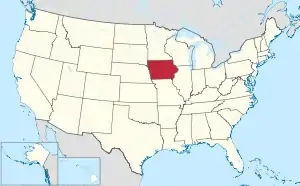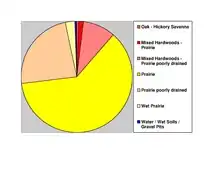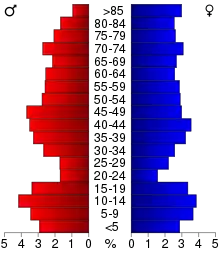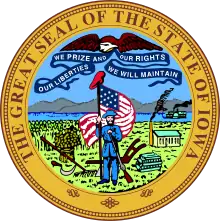Audubon County, Iowa
Audubon County is a county in the U.S. state of Iowa. As of the 2010 census, the population was 6,119,[1] making it Iowa's third-least populous county. Its county seat is Audubon.[2] The county was named after John James Audubon, the naturalist and artist.[3]
Audubon County | |
|---|---|
 Audubon County Courthouse in Audubon | |
 Location within the U.S. state of Iowa | |
 Iowa's location within the U.S. | |
| Coordinates: 41°41′05″N 94°54′29″W | |
| Country | |
| State | |
| Founded | 1851 |
| Named for | John James Audubon |
| Seat | Audubon |
| Largest city | Audubon |
| Area | |
| • Total | 443 sq mi (1,150 km2) |
| • Land | 443 sq mi (1,150 km2) |
| • Water | 0.4 sq mi (1 km2) 0.1% |
| Population (2010) | |
| • Total | 6,119 |
| • Estimate (2018) | 5,506 |
| • Density | 14/sq mi (5.3/km2) |
| Time zone | UTC−6 (Central) |
| • Summer (DST) | UTC−5 (CDT) |
| Congressional district | 4th |
| Website | www |
History
Audubon County was formed on January 15, 1851, from sections of Pottawattamie County. It was named after John James Audubon.[4] The current Audubon County Court House was opened in 1940.[5]
Geography
According to the U.S. Census Bureau, the county has an area of 443 square miles (1,150 km2), of which 443 square miles (1,150 km2) is land and 0.4 square miles (1.0 km2) (0.1%) is water.[6]

Major highways
.svg.png.webp) U.S. Highway 71
U.S. Highway 71 Iowa Highway 44
Iowa Highway 44 Iowa Highway 173
Iowa Highway 173
Adjacent counties
- Carroll County (north)
- Guthrie County (east)
- Cass County (south)
- Shelby County (west)
Demographics
| Historical population | |||
|---|---|---|---|
| Census | Pop. | %± | |
| 1860 | 454 | — | |
| 1870 | 1,212 | 167.0% | |
| 1880 | 7,448 | 514.5% | |
| 1890 | 12,412 | 66.6% | |
| 1900 | 13,626 | 9.8% | |
| 1910 | 12,671 | −7.0% | |
| 1920 | 12,520 | −1.2% | |
| 1930 | 12,264 | −2.0% | |
| 1940 | 11,790 | −3.9% | |
| 1950 | 11,579 | −1.8% | |
| 1960 | 10,919 | −5.7% | |
| 1970 | 9,595 | −12.1% | |
| 1980 | 8,559 | −10.8% | |
| 1990 | 7,334 | −14.3% | |
| 2000 | 6,830 | −6.9% | |
| 2010 | 6,119 | −10.4% | |
| 2018 (est.) | 5,506 | [7] | −10.0% |
| U.S. Decennial Census[8] 1790-1960[9] 1900-1990[10] 1990-2000[11] 2010-2018[1] | |||
2010 census
The 2010 census recorded a population of 6,119 in the county, with a population density of 13.813/sq mi (5.333/km2). There were 2,972 housing units, of which 2,617 were occupied.[12]
2000 census

As of the census[13] of 2000, there were 6,830 people, 2,773 households, and 1,927 families residing in the county. The population density was 15 people per square mile (6/km2). There were 2,995 housing units at an average density of 7 per square mile (3/km2). The racial makeup of the county was 99.17% White, 0.15% Black or African American, 0.09% Native American, 0.19% Asian, 0.03% from other races, and 0.38% from two or more races. 0.48% of the population were Hispanic or Latino of any race.
There were 2,773 households, out of which 30.10% had children under the age of 18 living with them, 61.40% were married couples living together, 5.60% had a female householder with no husband present, and 30.50% were non-families. 28.20% of all households were made up of individuals, and 16.70% had someone living alone who was 65 years of age or older. The average household size was 2.40 and the average family size was 2.94.
In the county, the population was spread out, with 25.90% under the age of 18, 5.00% from 18 to 24, 22.70% from 25 to 44, 22.90% from 45 to 64, and 23.50% who were 65 years of age or older. The median age was 42 years. For every 100 females there were 92.00 males. For every 100 females age 18 and over, there were 89.10 males.
The median income for a household in the county was $32,215, and the median income for a family was $37,288. Males had a median income of $28,090 versus $17,528 for females. The per capita income for the county was $17,489. About 6.70% of families and 7.70% of the population were below the poverty line, including 8.20% of those under age 18 and 7.80% of those age 65 or over.
Communities
Cities
Townships
Audubon County is divided into twelve townships:
Population ranking
The population ranking of the following table is based on the 2010 census of Audubon County.[14]
† county seat
| Rank | City/Town/etc. | Municipal type | Population (2010 Census) |
|---|---|---|---|
| 1 | † Audubon | City | 2,176 |
| 2 | Exira | City | 840 |
| 3 | Kimballton | City | 322 |
| 4 | Brayton | City | 128 |
| 5 | Gray | City | 63 |
Politics
| Year | Republican | Democratic | Third Parties |
|---|---|---|---|
| 2016 | 62.6% 2,136 | 31.7% 1,080 | 5.8% 196 |
| 2012 | 52.1% 1,802 | 46.6% 1,611 | 1.3% 44 |
| 2008 | 47.6% 1,634 | 50.6% 1,739 | 1.8% 63 |
| 2004 | 54.5% 1,958 | 44.8% 1,608 | 0.7% 26 |
| 2000 | 50.5% 1,909 | 47.0% 1,780 | 2.5% 95 |
| 1996 | 37.7% 1,314 | 52.4% 1,827 | 10.0% 347 |
| 1992 | 35.5% 1,373 | 41.0% 1,589 | 23.5% 911 |
| 1988 | 43.8% 1,478 | 55.3% 1,863 | 0.9% 30 |
| 1984 | 55.0% 2,306 | 44.2% 1,854 | 0.8% 35 |
| 1980 | 58.0% 2,523 | 35.5% 1,546 | 6.5% 284 |
| 1976 | 47.9% 1,978 | 50.9% 2,104 | 1.2% 51 |
| 1972 | 61.6% 2,515 | 37.6% 1,533 | 0.8% 34 |
| 1968 | 57.6% 2,592 | 38.0% 1,710 | 4.5% 202 |
| 1964 | 38.3% 1,871 | 61.6% 3,011 | 0.1% 3 |
| 1960 | 53.1% 2,935 | 46.9% 2,595 | 0.0% 2 |
| 1956 | 54.2% 3,057 | 45.8% 2,585 | 0.0% 2 |
| 1952 | 61.9% 3,605 | 38.1% 2,220 | 0.1% 4 |
| 1948 | 42.3% 2,177 | 55.1% 2,840 | 2.6% 136 |
| 1944 | 43.1% 2,346 | 56.8% 3,094 | 0.1% 7 |
| 1940 | 44.8% 2,632 | 55.1% 3,236 | 0.1% 7 |
| 1936 | 40.1% 2,344 | 59.1% 3,448 | 0.8% 47 |
| 1932 | 34.6% 1,604 | 64.5% 2,986 | 0.9% 43 |
| 1928 | 49.4% 2,340 | 50.0% 2,364 | 0.6% 29 |
| 1924 | 53.9% 2,475 | 21.0% 965 | 25.1% 1,155 |
| 1920 | 67.7% 2,963 | 32.1% 1,405 | 0.2% 10 |
| 1916 | 55.6% 1,581 | 43.9% 1,247 | 0.5% 15 |
| 1912 | 26.2% 692 | 36.4% 963 | 37.5% 991 |
| 1908 | 60.9% 1,701 | 37.6% 1,050 | 1.6% 44 |
| 1904 | 65.0% 1,843 | 32.9% 934 | 2.1% 59 |
| 1900 | 57.9% 1,821 | 41.3% 1,301 | 0.8% 25 |
| 1896 | 54.1% 1,705 | 45.0% 1,417 | 0.9% 27 |
See also
References
- "State & County QuickFacts". United States Census Bureau. Archived from the original on July 6, 2011. Retrieved July 13, 2014.
- "Find a County". National Association of Counties. Archived from the original on May 31, 2011. Retrieved 2011-06-07.
- Stennett, William H. (1908). A History of the Origin of the Place Names: Connected With the Chicago North Western and Chicago, St. Paul, Minneapolis Omaha Railways (2nd ed.). Chicago. p. 23. Retrieved April 5, 2019.
- Andrews, Henry Franklin (1915). History of Audubon County, Iowa: Its People, Industries, and Institutions. Brookhaven Press. p. 46. ISBN 9781581032413.
- "Audubon County Courthouse". Iowa Judicial Branch. Archived from the original on July 26, 2011. Retrieved February 9, 2011.
- "US Gazetteer files: 2010, 2000, and 1990". United States Census Bureau. 2011-02-12. Retrieved 2011-04-23.
- "Population and Housing Unit Estimates". Retrieved June 14, 2019.
- "U.S. Decennial Census". United States Census Bureau. Retrieved July 13, 2014.
- "Historical Census Browser". University of Virginia Library. Retrieved July 13, 2014.
- "Population of Counties by Decennial Census: 1900 to 1990". United States Census Bureau. Retrieved July 13, 2014.
- "Census 2000 PHC-T-4. Ranking Tables for Counties: 1990 and 2000" (PDF). United States Census Bureau. Retrieved July 13, 2014.
- "Population and Housing Occupancy Status: 2010 - State -- County". United States Census Bureau American FactFinder. Retrieved March 6, 2011.
- "U.S. Census website". United States Census Bureau. Retrieved January 31, 2008.
- "Archived copy". Retrieved February 13, 2016.
- Leip, David. "Dave Leip's Atlas of U.S. Presidential Elections". uselectionatlas.org. Retrieved 2018-04-25.
